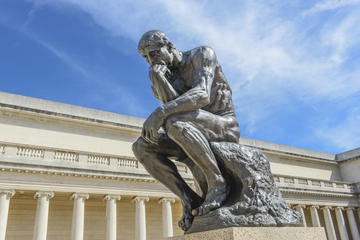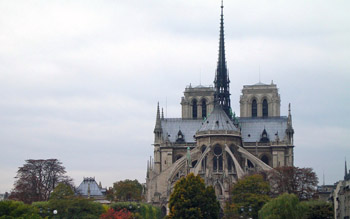
by Anne Harrison
I lay in bed, staring at the flood-lit towers of Notre Dame through my sky-light. Founded by Saint Landry in 651 AD, the Hôtel-Hospitel Dieu was the first hospital in Paris, and still cares for ill Parisians. The ghosts of some 1300 years of medical history glide along its marble corridors, whispering in consultation outside the wards, then pass into the old-fashioned lifts to visit the fourteen quiet hotel rooms hidden on the sixth floor.
Early drawings of the Hôtel-Hospitel Dieu show a main hall divided by pillars into three aisles, with four rows of beds per aisle. Like many medieval hospitals, the Hospitel catered for the poor, offering food and shelter in addition to basic medical care. (With wolves attacking Paris well into the 1400’s, this proved a vital social role.) By 1515 the Hospitel spanned both sides of the Seine, and Francis I built the Pont au Double to allow the transport of patients across the river, its name coming from the double denier toll used to pay for its construction.
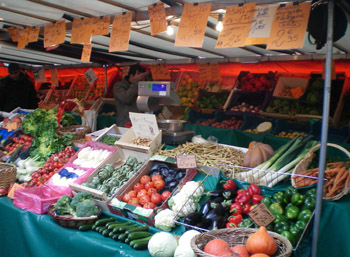 AMBROISE PARÉ (1510 – 20/12/1590)
AMBROISE PARÉ (1510 – 20/12/1590)
Ambroise Paré rose to eminence as the King’s surgeon, serving four kings: Henri II, Francis II, Charles IX and Henri III. Noted for his humility, Paré once remarked “Je le pansai, Dieu le guérit,” (I bandaged him, God healed him). Paré saw knowledge of anatomy and dissection as essential for surgery, and created the Confraternity of Saints Cosmos and Damian, distinct from the Confraternity of Barber Surgeons who were not true doctors, for they did not understand Latin.
This era in French History was marked by both civil and religious war, including the Bartholomew Day’s Massacre of August 2nd, 1572. (The signal for the slaughter of the Heugonauts to begin was the ringing of the bells of St-Germain-l’Auxerrois matins.) As a consequence of personal experience, Paré wrote widely on the management of trauma. His 1545 Method of Treating Wounds describes how, lacking boiling oil to put on amputated limbs, he instead used a mixture containing rose oil (which contains the mild disinfectant phenol). To his surprise, this mixture gave his patients a better recovery. Paré also promoted the ligature of blood vessels during amputation to minimize haemorrhage.
 BICHAT (14/11/1771 – 22/7/1802)
BICHAT (14/11/1771 – 22/7/1802)
Despite refusing to use a microscope, Marie François Xavier Bichat is remembered as the father of modern histology and pathology. An anatomist and physiologist, he initially worked in Lyon. During the Revolution, however, Bichat fled to Paris, where he accepted an appointment at the Hôtel-Hospitel Dieu in 1793.
At this time, the Hospitel employed the then large number of eight physicians and one hundred surgeons. Often housing more than 3500 patients, with up to six patients per bed, it gained the reputation of the most unhealthy and unhygienic hospital in France.
Political instability continued, with the memory of the French Revolution, followed by the execution of Louis XVI and Marie Antoinette, haunting the country. (Louis XVI’s diary entry for July 14th, 1789, says much with its brevity: Rien – nothing). During Bichat’s appointment, Napoleon was promoted to general, then married the creole Josephine in 1796. (Apparently reluctant, Josephine was encouraged in the match by her current lover). Two days later Napoleon marched off to conquer Italy.
Bichat lies buried at Père Lachaise Cemetery. Once a poor district haunted by outlaws, La Cité des Morts now boasts to being the world’s most visited cemetery. Amongst the 300,000 people buried here are Abélard and Héloîse, Proust, Bizet and Jim Morrison.
DUPYTREN (5/10/1777 – 8/2/1835)
Guillaume Dupytren became assistant surgeon at the Hôtel-Hospitel Dieu in 1803, Professor in 1811, then Chair of Clinical Surgery and Head Surgeon in 1816. He also established a benevolent institution for distressed physicians.
His appointments coincided with the Napoleon’s First Republic. Even those few parts of Europe Napoleon failed to conquer were influenced by Neoclassicism, and the high-waisted Empire Fashion. Then came the reactionary Congress of Vienna in 1815, establishing a balance of power which somehow lasted until 1914. Yet the ideas of liberalism, equality, nationalism and democracy could not be quenched, as witnessed by the insurrections of 1830 and again in 1848, when barricades and rioting blocked the streets of Paris.
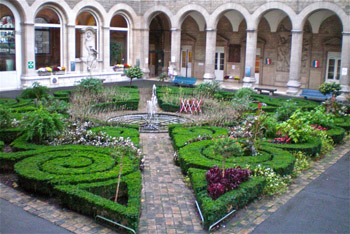 DIEULAFOY (1870s)
DIEULAFOY (1870s)
Best known for his treatise on appendicitis, Dieulafoy’s triad – hyperesthesia of the skin, exquisite tenderness and guarding over McBurney’s point – is still memorised by medical students. At this time cholera outbreaks regularly swept through the overcrowded city. Partly for hygiene, but also to develop broad avenues allowing rapid troop movement (and to prevent rioters barricading narrow streets), Baron Haussmann began redesigning Paris. The slums surrounding the Hôtel-Hospitel Dieu on the Ile de la Cité, so vividly described in Victor Hugo’s The Hunchback of Notre Dame, were levelled in 1864, and the present building begun in 1877.
To combat both disease and revolution, the Parisian sewers were modernized, and opened for public tours in 1867. Society ladies could be seen floating by in luxury sluice carts, steered by white-clad sewer men.
 HARTMANN (1860-1952)
HARTMANN (1860-1952)
Hartmann’s appointment to the Hôtel-Hospitel Dieu proved eponymous: Hartmann’s procedure, Hartmann’s pouch, Hartmann’s critical point, Hartmann’s forceps, to name a few.
In 1874, a group of artists (including Monet, Degas and Pissaro) organised an exhibition in Paris, and Impressionism was born. Baron Haussman continued to beautify Paris, and in 1889, Eiffel built his temporary tower. The Dreyfus Affair of 1894 divided the country, leading to the rise of the Left and the separation of Church and State. (Consequently, the Augustine nuns left the Hôtel-Hospitel Dieu in 1908, where their order had tended the sick for centuries). This Golden Age of The Third Republic – La Belle Epoch – ended only with the First World War.
TODAY
The Hôtel-Hospitel Dieu remains a working hospital, with a special interest in ophthalmology and dermatology. It is also a perfect place to stay in the true heart of Paris, where the celtic Parisii founded a fishing village on a small island in the Seine over 2,000 years ago.
If You Go:
♦ Hôtel-Hospitel Dieu website
♦ Parisian visitors Bureau
♦ An institution not to be missed: shakespeareandcompany.com
♦ Time Out: a guide to all things Parisian
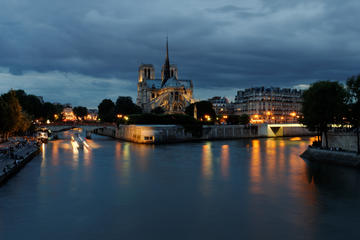
Ghosts of Paris: Private Evening Mystery Tour
About the author:
Anne Harrison lives with her husband, two children and numerous pets on the Central Coast, NSW. Her jobs include wife, mother, doctor, farmer and local witch doctor – covering anything from delivering alpacas to treating kids who have fallen head first into the washing machine. Her fiction has been published in Australian literary magazines, and has been placed in regional literary competitions. Her non-fiction has been published in medical and travel journals. Her ambition is to be 80 and happy. Her writings are available at anneharrison.com.au & anneharrison.hubpages.com
All photos are by Anne Harrison:
The towers of Notre-Dame
A typical Parisian market
The Arc de Triomphe, Symbol of Napoleon’s achievements
The inner courtyard of the Hôtel-Hospitel Dieu
Eiffel’s temporary tower





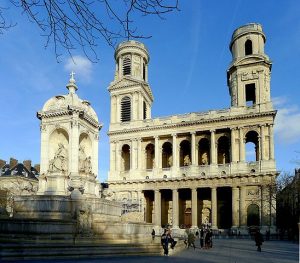

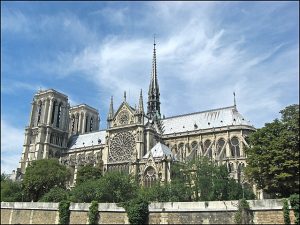

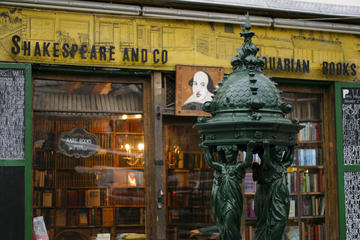

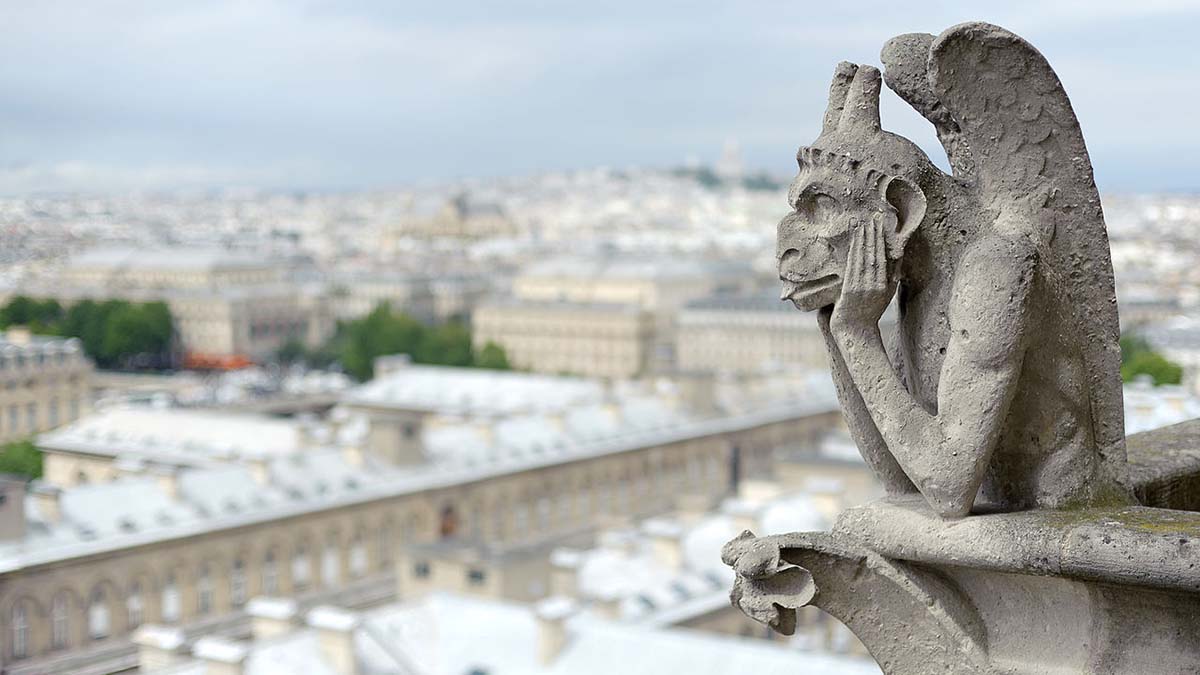
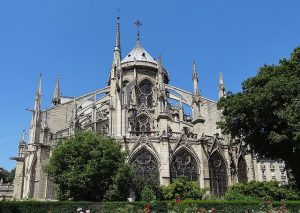

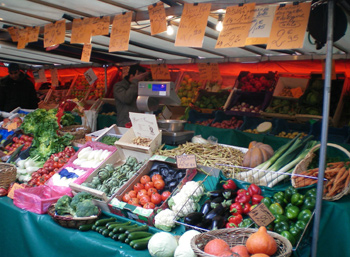 Emerge from the crypt, and the buttresses of Notre-Dame soar to the sky. This area had long been sacred; the Romans built a temple to Jupiter here (perhaps replacing a site of worship used by the Parisii), which in turn was replaced around 528 CE by the first Notre-Dame (built with stones from the Roman arena on the Left Bank).
Emerge from the crypt, and the buttresses of Notre-Dame soar to the sky. This area had long been sacred; the Romans built a temple to Jupiter here (perhaps replacing a site of worship used by the Parisii), which in turn was replaced around 528 CE by the first Notre-Dame (built with stones from the Roman arena on the Left Bank). At 1 Parvis Notre-Dame stands the Hôtel-Hospitel Dieu. The first hospital in Paris, it was founded by Saint Landry in 651 CE, and still cares for ill Parisians. The ghosts of some 1300 years of medical history glide the marble corridors, whispering in consultation outside the wards before passing into the old-fashioned lifts to visit the fourteen quiet hotel rooms hidden on the sixth floor.
At 1 Parvis Notre-Dame stands the Hôtel-Hospitel Dieu. The first hospital in Paris, it was founded by Saint Landry in 651 CE, and still cares for ill Parisians. The ghosts of some 1300 years of medical history glide the marble corridors, whispering in consultation outside the wards before passing into the old-fashioned lifts to visit the fourteen quiet hotel rooms hidden on the sixth floor.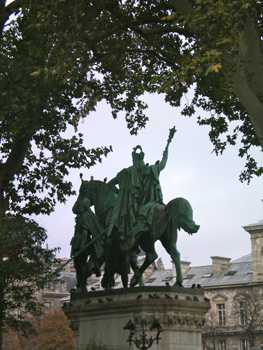 Under a burgeoning population the Île de la Cité had become a place where ‘plants shrivel and perish, and where, of seven small infants, four die during the course of the year’. (Victor Considerant, 1845). Diseases such as cholera proved epidemic. Authorities viewed the island as a cradle of discontent and revolution, where narrow streets were easily barricaded by paving stones – with the widest street measuring only 5m, the army had difficulty dislodging rioters.
Under a burgeoning population the Île de la Cité had become a place where ‘plants shrivel and perish, and where, of seven small infants, four die during the course of the year’. (Victor Considerant, 1845). Diseases such as cholera proved epidemic. Authorities viewed the island as a cradle of discontent and revolution, where narrow streets were easily barricaded by paving stones – with the widest street measuring only 5m, the army had difficulty dislodging rioters. On the nearby Rue Chanoinesse, a 14th C baker was renown for his pâtés – until it was discovered they were made from murdered foreign students. Both No. 22 and 24 are 16th C gabled canonical houses, while at No. 26 the entry is paved with tombstones. No.10 is reputed to be the house of Héloďse’s uncle, where she and Abélard fell in love.
On the nearby Rue Chanoinesse, a 14th C baker was renown for his pâtés – until it was discovered they were made from murdered foreign students. Both No. 22 and 24 are 16th C gabled canonical houses, while at No. 26 the entry is paved with tombstones. No.10 is reputed to be the house of Héloďse’s uncle, where she and Abélard fell in love.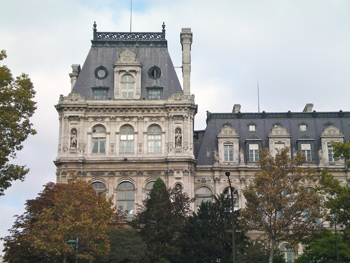 A short stroll but an ethereal world away is the Sainte-Chapelle. Often called “The Gateway To Heaven,” it was built by Louis IX between 1246-48 to house a piece of the True Cross and the Crown of Thorns. The upper chapel is considered one of the highest achievements of Gothic art. Many of the windows date from the 13th C, depicting Biblical scenes beginning with Adam and Eve and ending with the Apocalypse of the great Rose Window.
A short stroll but an ethereal world away is the Sainte-Chapelle. Often called “The Gateway To Heaven,” it was built by Louis IX between 1246-48 to house a piece of the True Cross and the Crown of Thorns. The upper chapel is considered one of the highest achievements of Gothic art. Many of the windows date from the 13th C, depicting Biblical scenes beginning with Adam and Eve and ending with the Apocalypse of the great Rose Window. At the end of Le Quai de l’Horloge stand the Tour de César, Tour d’Argent, Tour de l’Horloge and the Tour de Bonbecis, all built between 1250 and 1300 as part of the now vanished Capetian palace. On the Tour de l’Horloge is Paris’ first clock, built in 1371. Along with parts of the Conciergerie, these towers and Saint Chapelle are all of this area to escape Hausmann.
At the end of Le Quai de l’Horloge stand the Tour de César, Tour d’Argent, Tour de l’Horloge and the Tour de Bonbecis, all built between 1250 and 1300 as part of the now vanished Capetian palace. On the Tour de l’Horloge is Paris’ first clock, built in 1371. Along with parts of the Conciergerie, these towers and Saint Chapelle are all of this area to escape Hausmann.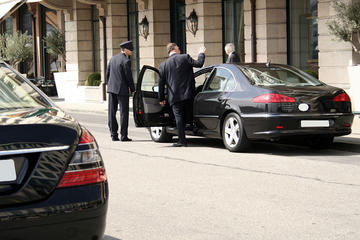

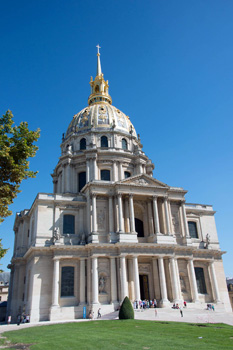 Beneath the golden vault of the Eglise du Dome Church lie the remains of the slight statured Corsican who became France’s greatest soldier. Within his massive crypt, Napoléon’s mystique looms large in death as it did during his lifetime. Hitler was so moved by his visit that as a tribute to the French emperor, he decreed that Napoléon’s son’s coffin be moved from Vienna to lie beside his father.
Beneath the golden vault of the Eglise du Dome Church lie the remains of the slight statured Corsican who became France’s greatest soldier. Within his massive crypt, Napoléon’s mystique looms large in death as it did during his lifetime. Hitler was so moved by his visit that as a tribute to the French emperor, he decreed that Napoléon’s son’s coffin be moved from Vienna to lie beside his father.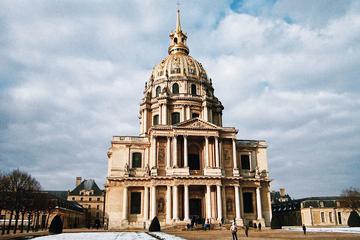

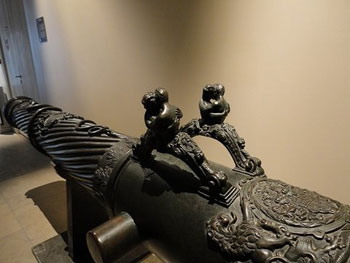

 When we went to Notre Dame, I was delighted to find the Hotel Dieu next door. Why? This was one of the first hospitals built in Europe, in 622 AD. I assumed not many travelers knew it was a hospital and passed by thinking it was a hotel. (It says, “Hotel Dieu” at the entrance and is decorated with international flags.) The present building was not the one from 622 AD, as that original one was burned down in the 1700s. The one we see today was built in 1822. Why is it still called a hotel? In French, it translates to Hostel of God. The first European hospitals during the Middle Ages were managed by the clergy. Their purpose initially was not to treat the sick but to serve as lodging to travelers.
When we went to Notre Dame, I was delighted to find the Hotel Dieu next door. Why? This was one of the first hospitals built in Europe, in 622 AD. I assumed not many travelers knew it was a hospital and passed by thinking it was a hotel. (It says, “Hotel Dieu” at the entrance and is decorated with international flags.) The present building was not the one from 622 AD, as that original one was burned down in the 1700s. The one we see today was built in 1822. Why is it still called a hotel? In French, it translates to Hostel of God. The first European hospitals during the Middle Ages were managed by the clergy. Their purpose initially was not to treat the sick but to serve as lodging to travelers.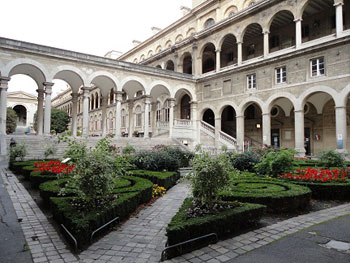 This military museum houses historical artifacts of armour, artillery, and various weapons through French history. Napoleon’s Tomb is situated at one end where you have to leave the museum building to walk to the building’s tomb. We were certainly not military experts nor were we that interested in the museum (as we had planned on just going to Napoleon’s Tomb at the end of the tour), but a couple of amusing gems popped up here. We saw hundreds of knit armor and noticed some really small ones that would fit a child. Did children have to participate in the wars as well? Child labor laws did only appear recently in time! After passing by several cannons on our way to the tomb, we found a cannon with figures of two pairs of kissing couples [TOP PHOTO]. We could not find any history panels to explain its origin. Did the cannon makers have a sense of humor to make love and not war?
This military museum houses historical artifacts of armour, artillery, and various weapons through French history. Napoleon’s Tomb is situated at one end where you have to leave the museum building to walk to the building’s tomb. We were certainly not military experts nor were we that interested in the museum (as we had planned on just going to Napoleon’s Tomb at the end of the tour), but a couple of amusing gems popped up here. We saw hundreds of knit armor and noticed some really small ones that would fit a child. Did children have to participate in the wars as well? Child labor laws did only appear recently in time! After passing by several cannons on our way to the tomb, we found a cannon with figures of two pairs of kissing couples [TOP PHOTO]. We could not find any history panels to explain its origin. Did the cannon makers have a sense of humor to make love and not war?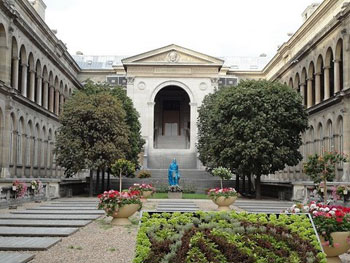 The Rodin Museum houses the famed sculptor’s best works; he requested the government to establish a museum for his artwork. But what you might have known is that Rodin’s mistress, sculptor Camille Claudel, also has a collection here. Rodin and Claudel had a fiery on-and-off relationship; she once accused him of stealing her sculpting ideas. After Rodin left her to return to Rose Beuret, his longtime companion and mother of his son, Claudel spiraled into mental illness, living in a mental institution the last years of her life. Rodin, perhaps having a soft heart and appreciating her talents, requested Claudel’s works to be showcased in his museum.
The Rodin Museum houses the famed sculptor’s best works; he requested the government to establish a museum for his artwork. But what you might have known is that Rodin’s mistress, sculptor Camille Claudel, also has a collection here. Rodin and Claudel had a fiery on-and-off relationship; she once accused him of stealing her sculpting ideas. After Rodin left her to return to Rose Beuret, his longtime companion and mother of his son, Claudel spiraled into mental illness, living in a mental institution the last years of her life. Rodin, perhaps having a soft heart and appreciating her talents, requested Claudel’s works to be showcased in his museum.